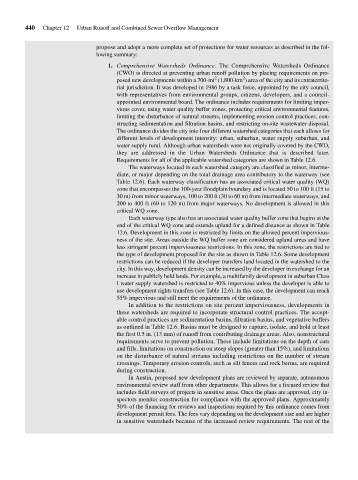Page 482 - Fair, Geyer, and Okun's Water and wastewater engineering : water supply and wastewater removal
P. 482
JWCL344_ch12_398-456.qxd 8/4/10 9:37 PM Page 440
440 Chapter 12 Urban Runoff and Combined Sewer Overflow Management
propose and adopt a more complete set of protections for water resources as described in the fol-
lowing summary:
1. Comprehensive Watersheds Ordinance. The Comprehensive Watersheds Ordinance
(CWO) is directed at preventing urban runoff pollution by placing requirements on pro-
2
2
posed new developments within a 700-mi (1,800-km ) area of the city and its extraterrito-
rial jurisdiction. It was developed in 1986 by a task force, appointed by the city council,
with representatives from environmental groups, citizens, developers, and a council-
appointed environmental board. The ordinance includes requirements for limiting imper-
vious cover, using water quality buffer zones, protecting critical environmental features,
limiting the disturbance of natural streams, implementing erosion control practices, con-
structing sedimentation and filtration basins, and restricting on-site wastewater disposal.
The ordinance divides the city into four different watershed categories that each allows for
different levels of development intensity: urban, suburban, water supply suburban, and
water supply rural. Although urban watersheds were not originally covered by the CWO,
they are addressed in the Urban Watersheds Ordinance that is described later.
Requirements for all of the applicable watershed categories are shown in Table 12.6.
The waterways located in each watershed category are classified as minor, interme-
diate, or major depending on the total drainage area contributory to the waterway (see
Table 12.6). Each waterway classification has an associated critical water quality (WQ)
zone that encompasses the 100-year floodplain boundary and is located 50 to 100 ft (15 to
30 m) from minor waterways, 100 to 200 ft (30 to 60 m) from intermediate waterways, and
200 to 400 ft (60 to 120 m) from major waterways. No development is allowed in this
critical WQ zone.
Each waterway type also has an associated water quality buffer zone that begins at the
end of the critical WQ zone and extends upland for a defined distance as shown in Table
12.6. Development in this zone is restricted by limits on the allowed percent impervious-
ness of the site. Areas outside the WQ buffer zone are considered upland areas and have
less stringent percent imperviousness restrictions. In this zone, the restrictions are tied to
the type of development proposed for the site as shown in Table 12.6. Some development
restrictions can be reduced if the developer transfers land located in the watershed to the
city. In this way, development density can be increased by the developer in exchange for an
increase in publicly held lands. For example, a multifamily development in suburban Class
I water supply watershed is restricted to 40% impervious unless the developer is able to
use development rights transfers (see Table 12.6). In this case, the development can reach
55% impervious and still meet the requirements of the ordinance.
In addition to the restrictions on site percent imperviousness, developments in
these watersheds are required to incorporate structural control practices. The accept-
able control practices are sedimentation basins, filtration basins, and vegetative buffers
as outlined in Table 12.6. Basins must be designed to capture, isolate, and hold at least
the first 0.5 in. (13 mm) of runoff from contributing drainage areas. Also, nonstructural
requirements serve to prevent pollution. These include limitations on the depth of cuts
and fills, limitations on construction on steep slopes (greater than 15%), and limitations
on the disturbance of natural streams including restrictions on the number of stream
crossings. Temporary erosion controls, such as silt fences and rock berms, are required
during construction.
In Austin, proposed new development plans are reviewed by separate, autonomous
environmental review staff from other departments. This allows for a focused review that
includes field surveys of projects in sensitive areas. Once the plans are approved, city in-
spectors monitor construction for compliance with the approved plans. Approximately
50% of the financing for reviews and inspections required by this ordinance comes from
development permit fees. The fees vary depending on the development size and are higher
in sensitive watersheds because of the increased review requirements. The rest of the

